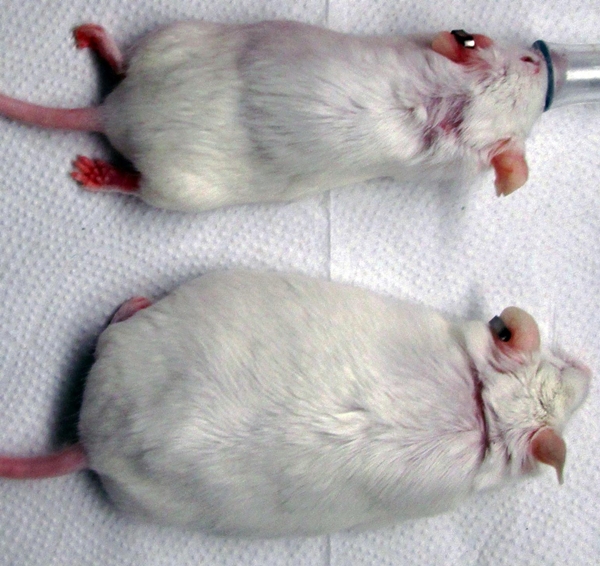
Mouse given skin graft expressing GLP-1 protein at top, compared to untreated mouse, after both were given high-fat diets. (Wu Laboratory, University of Chicago)
4 August 2017. Skin grafts derived from genetically edited stem cells were shown in tests with lab mice to reduce glucose levels and weight gain that result from a high-fat diet. Results of research by a team from University of Chicago medical center appear in yesterday’s issue of the journal Cell Stem Cell.
Researchers led by cell biologist Xiaoyang Wu are seeking techniques using the skin to deliver treatments for diseases. As the authors note, the skin is the largest and most accessible human organ, with a long record of applications in health care including skin grafts for wound healing and rejuvenation of new skin from stem cells. In this case, the team is expanding on these methods to develop new techniques for treating type 2 diabetes.
Diabetes is a chronic disorder where the pancreas does not create enough insulin to process the sugar glucose to flow into the blood stream and cells for energy in the body. In type 2 diabetes, which accounts for at least 90 percent of all diabetes cases, the pancreas produces some but not enough insulin, or the body cannot process insulin. According to the International Diabetes Federation, diabetes affects an estimated 415 million people worldwide, of which 44 million are in North America.
Wu and colleagues designed a solution using skin stem cells from new-born mice. The researchers used the genome-editing technique Crispr — short for clustered regularly interspaced short palindromic repeats — with the editing enzyme Cas9 to alter the mouse gene producing the glucagon-like peptide 1 protein, or GLP-1, that promotes production of insulin in the pancreas. The gene was further edited to respond to the common antibiotic doxycycline, making it possible to trigger release of GLP-1 when in its presence, even in very small amounts. The team also edited the mouse genes to reduce immune system rejection, and extend its stability and potency.
In the lab, the researchers grew three-dimensional cell clusters called organoids from the engineered stem cells with layers similar to normal mouse skin. The organoids were transplanted to the test mice, with little immune-system rejection reported. The organoid transplants were largely successful and stable after 3 months, continuing to produce GLP-1 protein and responding to doxycycline triggers.
The team tested the ability of the engineered skin grafts to control glucose levels on lab mice fed a high-fat diet to induce obesity and insulin resistance similar to type 2 diabetes. The mice were randomly assigned to received skin grafts from the edited stem cells or remain untreated. When given drinking water with small amounts of doxycycline, mice with the skin grafts produced more GLP-1 proteins, enabling the mice to produce more insulin compared to the untreated mice, as well as lower their glucose levels and resistance to insulin.
The researchers tested the technique as well with human skin stem cells, developed into organoids and transplanted in genetically-altered test mice with reduced T-cells to minimize immune reactions, often called “nude” mice because their lack of body fur. Like the earlier tests with wild mice, the mice with human skin grafts produced more GLP-1 proteins in the presence of doxycycline to produce more insulin.
The authors consider the study a proof-of-concept not only for type 2 diabetes, but for engineered skin grafts to treat other diseases, where somatic or non-inherited genes can be altered and transferred.
More from Science & Enterprise:
- Synthetic Beating Heart Repair Tissue Being Developed
- Crispr, Stem Cells Produce Precise Arthritis Therapy
- Umbilical Cord Blood Evaluated for Autism Treatment
- Genetic Techniques Speed Brain, Muscle Cell Production
- Cell Biotech Gains Organoid Technology
* * *

 RSS - Posts
RSS - Posts
[…] Gene-Edited Skin Grafts Shown to Control Glucose Levels […]
[…] Gene-Edited Skin Grafts Shown to Control Glucose Levels […]